- Home
- Jennifer Niven
All the Bright Places Page 27
All the Bright Places Read online
Page 27
The car crawls back along Private Road the way I came, and that’s when I see the bend in the road that I didn’t take, a kind of fork. I follow this now, and there’s the lake, and then I see the sign: TAYLOR PRAYER CHAPEL.
A wooden cross, tall as a man, sits in front of the sign by a few feet, and behind the cross and the sign is a tiny white chapel with a tiny white steeple. I can see houses beyond, and the lake to one side, the top of it green with algae.
I turn off the engine and sit for a few minutes. I lose track of how long I’m there. Did he come here the day he died? Did he come here the day before? When was he here? How did he find this place?
Then I am out of the car and walking to the chapel, and I can hear my heart and, somewhere in the distance, the sounds of birds in the trees. The air is already heavy with summer.
I turn the knob, and the door opens, just like that, and inside the chapel smells fresh and clean, as if it has been aired out recently. There are only a few pews, because the entire place is smaller than my bedroom, and at the front a wooden altar with a painting of Jesus and two vases of flowers, two potted plants, and an open Bible.
The long, narrow windows let in the sunlight, and I sit in one of the pews and look around, thinking: What now?
I walk to the altar, and someone has typed up and laminated a history of the church, which is propped against one of the vases of flowers.
Taylor Prayer Chapel was created as a sanctuary for weary travelers to stop and rest along their way. It was built in memoriam to those who have lost their lives in auto accidents, and as a place of healing. We remember those who are no longer here, who were taken from us too soon, and who we will always keep with us in our hearts. The chapel is open to the public day and night, and on holidays. We are always here.
And now I know why Finch chose this place—for Eleanor and for me. And for him too, because he was a weary traveler who just needed rest. Something pokes out of the Bible—a white envelope. I turn to the page, and someone has underlined these words: “Then you will shine among them like stars in the sky.”
I pick up the envelope, and there is my name: “Ultraviolet Remarkey-able.”
I think of taking it to the car to read what’s inside, but instead I sit down in one of the pews, grateful for the sturdy, solid wood underneath me.
Am I ready to hear what he thought of me? To hear how I let him down? Am I ready to know exactly how much I hurt him and how I could have, should have, saved him, if only I’d paid more attention and read the signs and not opened my big mouth and listened to him and been enough and maybe loved him more?
My hands are shaking as I open the envelope. I pull out three sheets of thick staff paper, one covered in musical notes, the other two covered in words that look like lyrics.
I begin to read.
You make me happy,
Whenever you’re around I’m safe inside your smile,
You make me handsome,
Whenever I feel my nose just seems a bit too round,
You make me special, and God knows I’ve longed to be that kind of guy to have around,
You make me love you,
And that could be the greatest thing my heart was ever fit to do.…
I am crying—loud and hiccuping, as if I’ve been holding my breath for a very long time and finally, finally can breathe.
You make me lovely, and it’s so lovely to be lovely to the one I love.…
I read and reread the words.
You make me happy …
You make me special …
You make me lovely …
I read and reread them until I know the words by heart, and then I fold up the papers and slide them back into the envelope. I sit there until the tears stop, and the light begins to change and fade, and the soft, pink glow of dusk fills the chapel.
It’s dark by the time I drive home. In my bedroom, I pull out the staff paper once again and play the notes on my flute. The tune finds its way into my head and stays there, like it’s a part of me, so that, days later, I’m still singing it.
I don’t need to worry that Finch and I never filmed our wanderings. It’s okay that we didn’t collect souvenirs or that we never had time to pull it all together in a way that made sense to anyone else but us.
The thing I realize is that it’s not what you take, it’s what you leave.
VIOLET
June 20
It’s a white-hot summer day. The sky is a pure, bright blue. I park the car and walk up the embankment and stand for a long time on the grassy shore of the Blue Hole. I half expect to see him.
I kick off my shoes and cut through the water, diving deep. I’m looking for him through my goggles, even though I know I won’t find him. I swim with my eyes open. I come back up to the surface under the great wide sky, take a breath, and down I go again, deeper this time. I like to think he’s wandering in another world, seeing things no one can ever imagine.
In 1950, poet Cesare Pavese was at the peak of his literary career, applauded by his peers and his country as the greatest living Italian author. In August of that year, he took a lethal dose of sleeping pills, and even though he kept a daily journal, no one could ever truly explain why he did it. The writer Natalia Ginzburg remembered him after his death: “It seemed to us that his sadness was that of a boy, the voluptuous heedless melancholy of a boy who has still not come down to earth, and moves in the arid, solitary world of dreams.”
It was an epitaph that could have been written for Finch, except that I’ve written one for him myself:
Theodore Finch—I was alive. I burned brightly. And then I died, but not really. Because someone like me cannot, will not, die like everyone else. I linger like the legends of the Blue Hole. I will always be here, in the offerings and people I left behind.
I tread water on the surface under the wide, open sky and the sun and all that blue, which reminds me of Theodore Finch, just like everything else reminds me of him, and I think of my own epitaph, still to be written, and all the places I’ll wander. No longer rooted, but gold, flowing. I feel a thousand capacities spring up in me.
AUTHOR’S NOTE
Every forty seconds, someone in the world dies by suicide. Every forty seconds, someone is left behind to cope with the loss.
Long before I was born, my great-grandfather died of a self-inflicted gunshot wound. His oldest child, my grandfather, was just thirteen. No one knew if it was intentional or accidental—and being from a small town in the South, my grandfather and his mother and sisters never discussed it. But that death has affected our family for generations.
Several years ago, a boy I knew and loved killed himself. I was the one who discovered him. The experience was not something I wanted to talk about, even with the people closest to me. To this day, many of my family and friends still don’t know much, if anything, about it. For a long time, it was too painful to even think about, much less talk about, but it is important to talk about what happened.
In All the Bright Places, Finch worries a lot about labels. There is, unfortunately, a good deal of stigma surrounding suicide and mental illness. When my great-grandfather died, people gossiped. Although his widow and his three children never spoke about what happened that day, they felt silently judged and, to some extent, ostracized. I lost my friend to suicide a year before I lost my father to cancer. They were both ill at the same time, and they died within fourteen months of each other, but the reaction to their illnesses and deaths could not have been more different. People rarely bring flowers to a suicide.
It was only when writing this book that I learned my own label—Survivor After Suicide, or Survivor of Suicide. Fortunately, there are numerous resources to help me make sense of this tragic thing that happened and how it affects me, just as there are numerous resources to help anyone, teen or adult, who is struggling with emotional upheaval, depression, anxiety, mental instability, or suicidal thoughts.
Often, mental and emotional illnesses go undiagnosed because the p
erson suffering symptoms is too ashamed to speak up, or because their loved ones either fail to or choose not to recognize the signs. According to Mental Health America, an estimated 2.5 million Americans are known to have bipolar disorder, but the actual number is a good two to three times higher than that. As many as 80 percent of people with this illness go undiagnosed or misdiagnosed.
If you think something is wrong, speak up.
You are not alone.
It is not your fault.
Help is out there.
SUICIDE PREVENTION
American Association of Suicidology (AAS)—suicidology.org
American Foundation for Suicide Prevention (AFSP)—afsp.org
IMAlive—imalive.org
National Suicide Prevention Lifeline—
suicidepreventionlifeline.org (1-800-273-TALK)
DIAGNOSING MENTAL ILLNESS IN TEENS
Helpguide—helpguide.org
Mental Health America (MHA)—mentalhealthamerica.net
National Alliance on Mental Illness (NAMI)—nami.org
National Institute of Mental Health (NIMH)—nimh.nih.gov
Teen Mental Health—teenmentalhealth.org
SURVIVORS
Mayo Clinic—mayoclinic.com/health/suicide/MH00048
SOS: A Handbook for Survivors of Suicide by Jeffrey Jackson (published by AAS)— available online, along with other helpful resources, at www.suicidology.org/suicide-survivors/suicide-loss-survivors
BULLYING
Stomp Out Bullying—stompoutbullying.org
StopBullying—stopbullying.gov
ABUSE
Childhelp—childhelpusa.org
National Child Abuse Hotline—1-800-4-A-CHILD (1-800-422-4453)
ACKNOWLEDGMENTS
In June of 2013, two days after finishing up work on my seventh book and sending it off to my New York publisher, I had an idea for another story, in spite of the fact that I was burned out and ready for a much-needed break—I’ve been writing back-to-back books for the past couple of years.
This idea was different, however. For one thing, it was personal. For another, it was YA. I’ve spent my career in adult fiction and nonfiction but, creatively, I was ready for something different.
I wanted to write something edgy.
I wanted to write something contemporary.
I wanted to write something tough, hard, sad, but funny.
I wanted to write from a boy’s point of view.
In July, I signed with the most wonderful and amazing agent (champion, partner, editor) a girl could have. Thank you to the incomparable Kerry Sparks for believing in that first fifty pages and me. No one will ever know what her belief and enthusiasm meant at that particular time in my life. I wake up every day counting my lucky stars for Kerry and all the fantastic folks at Levine Greenberg Rostan (especial thanks to Monika Verma and Elizabeth Fisher). They make me lovely.
So does Allison Wortche, my brilliant editor, who is as savvy and insightful as she is warm and kind, and who is as invested in Finch and Violet as I am. Their story would not be the same without her skilled hand. She and the entire team at Knopf and Random House Children’s Books (President and Publisher Barbara Marcus; Vice President and Publishing Director Nancy Hinkel; Senior Vice President and Associate Publisher Judith Haut; Isabel Warren-Lynch, Alison Impey, and Stephanie Moss in Design; Artie Bennett, as well as aces Renée Cafiero and Katharine Wiencke, in Copyediting; Managing Editor Shasta Clinch; Tim Terhune and Barbara Cho in Production; Pam White and Jocelyn Lange in Sub Rights; Felicia Frazier, John Adamo, Kim Lauber, Lynn Kestin, Stephanie O’Cain, Adrienne Waintraub, Laura Antonacci, Dominique Cimina, Lydia Finn, and the rest of Sales, Marketing, and Publicity) have created the brightest of places for me to live, breathe, and work, and I am thrilled out of my head to be there.
I’m also thrilled to be working with my wondrous film agent, Sylvie Rabineau, and RWSG Literary Agency.
Thank you to my family and friends for unwavering support, even when I am insufferably consumed by my work (which is most of the time). I couldn’t do it without you. Special thanks to my favorite cousin, Annalise von Sprecken, my consultant on all things teen-related and the person who gave me “________ is life.”
Thank you to Louis, love of my life and partner in more ways than one, who has had to endure hours of worrying, brainstorming, outlining, suicide-fact reciting, querying (“What if Violet and Finch met on the bell tower ledge?” “What if Finch and Roamer used to be friends?” “What if Amanda was at Life Is Life too?”), not to mention hours of One Direction listening (my own personal Boy Parade). He, more than anyone else (with the exception of our three literary cats), has lived this book with me.
Thank you, John Ivers (Blue Flash, Blue Too) and Mike Carmichael (World’s Biggest Ball of Paint), for creating such uniquely awesome, wander-worthy sites, and for letting me use your real names.
Thank you to my very first editor, Will Schwalbe, who remains a wise mentor and cherished friend. And to Amanda Brower and Jennifer Gerson Uffalussy for leading me to Kerry Sparks.
Thank you, Briana Harley, for being my go-to one-girl band of a YA focus group. Thank you, Lara Yacoubian, for being the World’s Best Assistant Ever.
Thanks to the Germ girls and guys for all you are and do, particularly Louis, Jordan, Briana Bailey, Shannon, Shelby, and Lara. You are the prettiest girls (and boys) anywhere.
Thank you to the generous people (who wish to remain nameless) who shared their personal stories of mental illness, depression, and suicide. And to the experts at the American Association of Suicidology, the Mayo Clinic, and the National Institute of Mental Health.
Thanks most of all to my beautiful mother and fellow author, Penelope Niven, who made the world lovelier just by being in it. She was my best friend. She was my best everything.
We used to say to each other, “You are my best.” And she was. And she always will be. She taught me from childhood that my mountain was waiting, and she never stopped encouraging me to keep climbing. Her unexpected death on August 28, 2014, was the single worst event of my life. This book, and all the books to follow, are because of her and for her. To quote Theodore Finch, You are all the colors in one, at full brightness.
Lastly, thanks to my great-grandfather Olin Niven. And to the boy I loved who died too soon, but who left me a song.
And in two weeks we’ll fly again,
perhaps a Chinese dinner then.
You make me happy, you make me smile.
ABOUT THE AUTHOR
All the Bright Places is Jennifer Niven’s first book for young adult readers, but she has written four novels for adults—American Blonde, Becoming Clementine, Velva Jean Learns to Fly, and Velva Jean Learns to Drive—as well as three nonfiction books—The Ice Master, Ada Blackjack, and The Aqua Net Diaries, a memoir about her high school experiences. Although she grew up in Indiana, she now lives with her fiancé and three literary cats in Los Angeles, which remains her favorite place to wander. For more information, visit JenniferNiven.com and GermMagazine.com, or find her on Facebook.

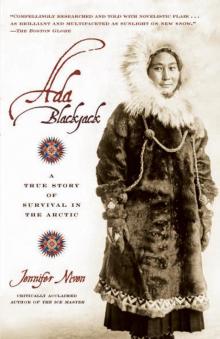 Ada Blackjack: A True Story of Survival in the Arctic
Ada Blackjack: A True Story of Survival in the Arctic The Aqua Net Diaries: Big Hair, Big Dreams, Small Town
The Aqua Net Diaries: Big Hair, Big Dreams, Small Town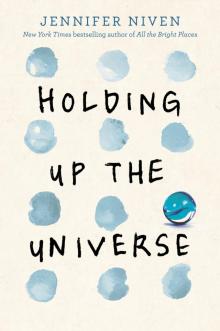 Holding Up the Universe
Holding Up the Universe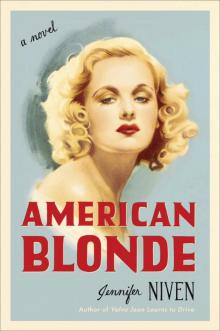 American Blonde
American Blonde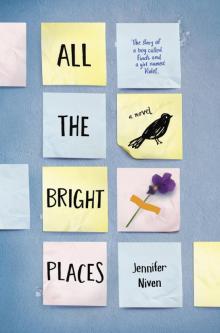 All the Bright Places
All the Bright Places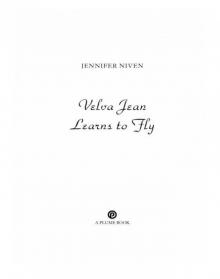 Velva Jean Learns to Fly
Velva Jean Learns to Fly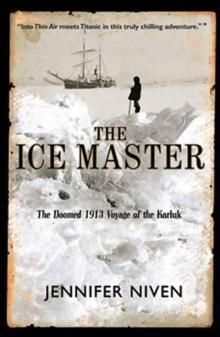 The Ice Master
The Ice Master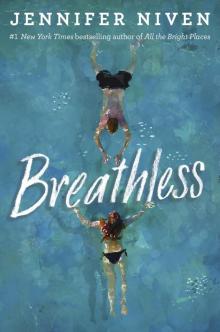 Breathless
Breathless The Aqua Net Diaries
The Aqua Net Diaries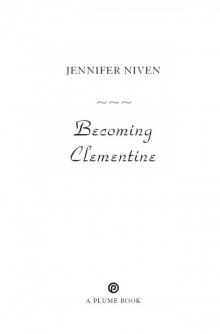 Becoming Clementine: A Novel
Becoming Clementine: A Novel